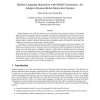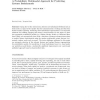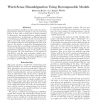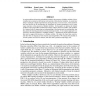ITA
2006
14 years 7 months ago
2006
In this work we study some probabilistic models for the random generation of words over a given alphabet used in the literature in connection with pattern statistics. Our goal is t...
IJCV
2008
14 years 7 months ago
2008
We develop hierarchical, probabilistic models for objects, the parts composing them, and the visual scenes surrounding them. Our approach couples topic models originally developed...
CONNECTION
2008
14 years 7 months ago
2008
Spoken language is one of the most intuitive forms of interaction between humans and agents. Unfortunately, agents that interact with people using natural language often experienc...
AAMAS
2010
Springer
14 years 7 months ago
2010
Springer
During face-to-face interactions, listeners use backchannel feedback such as head nods as a signal to the speaker that the communication is working and that they should continue sp...
ICML
2010
IEEE
14 years 8 months ago
2010
IEEE
For centuries, scholars have explored the deep links among human languages. In this paper, we present a class of probabilistic models that use these links as a form of naturally o...
UAI
2007
14 years 8 months ago
2007
This paper is part of a project to match descriptions of real-world instances and probabilistic models, both of which can be described at mulvel of abstraction and detail. We use ...
ACL
1994
14 years 8 months ago
1994
Most probabilistic classi ers used for word-sense disambiguationhave either been based on onlyone contextual feature or have used a model that is simply assumed to characterize th...
NIPS
2000
14 years 8 months ago
2000
A serious problem in learning probabilistic models is the presence of hidden variables. These variables are not observed, yet interact with several of the observed variables. As s...
AAAI
1998
14 years 8 months ago
1998
Probabilistic models have recently been utilized for the optimization of large combinatorial search problems. However, complex probabilistic models that attempt to capture interpa...
UAI
2001
14 years 8 months ago
2001
A serious problem in learning probabilistic models is the presence of hidden variables. These variables are not observed, yet interact with several of the observed variables. Dete...




